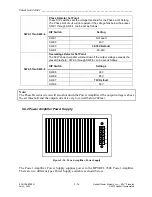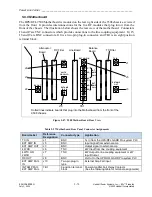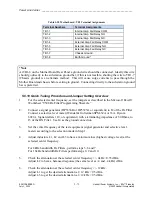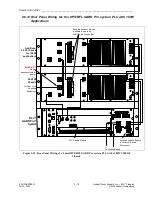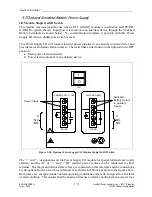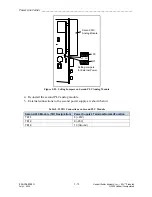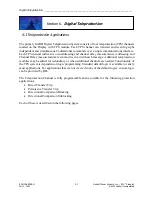
Power Line Carrier ____________________________________________________________________
RF-MCGARDPRO
Hubbell Power Systems, Inc.
–
RFL™
Products
July 1, 2022
©2022 Hubbell Incorporated
5-65
5.6.5.1.1 Hybrid Transformers
The HPS/RFL 9508 Line Board contains two hybrid transformers, T3 and T4. The primary
winding of T3 accepts the transmit input signal, and the primary winding of T4 develops the
receive output signal that is passed to the RX Filter.
Both hybrid transformers have two secondary windings and are interconnected so that one
secondary of T3 is in series with a secondary of T4. One set of secondaries is connected across
the complex balance network, and the other set of secondaries is connected to the line coupling
equipment through line matching transformer T2. Fuses F1 and F2 provide overcurrent
protection, and surge arrestors E1 and E2, protect the equipment against an overvoltage condition.
For four wire applications, the signal going to the line coupling equipment can be monitored at
TP2, and the signal coming from the line coupling equipment can be monitored at TP3. For two
wire applications the signal going to or coming from the line coupling equipment can be
monitored at TP2.
5.6.5.1.2 Receive Attenuator
Resistors R9, R11, R12 and dual-section Receive Level potentiometer R10 are connected across
the primary of T4 to form an attenuator. The amount of signal sent to the RX Filter is controlled
by the setting of R10. Zener diodes CR1 and CR2 clamp the signal to a safe level. The signal
being sent to the RX Filter can be monitored at test points TP6 and TP7.
5.6.5.1.3 Complex Balance Network
Inductors L1 through L8, capacitors C1 through C9, Coarse Switch S1, fine potentiometer R1
and resistors R2 through R8 form an internal reactive balance network. This network is connected
across one set of secondaries of the hybrid transformers. Jumper J13 can be used to enable or
disable the internal balance network. The balance network is adjusted to match the line
impedance. To adjust the network, a frequency selective voltmeter (FSVM) is connected across
test points TP6 and TP7 on the Line Board, and S1 and R1 are adjusted to the lowest possible
transmitter signal level. S1 provides a rough adjustment of the resistance across the hybrid
secondaries by determining how many resistors in the network are connected in series. R1
provides a fine resistance adjustment that allows the resistive balance to be precisely set.
Inductors L1 through L8 and capacitors C1 through C9 form the reactive portion of the balance
network. All components in the reactive portion can be jumpered in or out to balance out local
line reactance. L1 through L8 can be enabled or disabled by jumpers J13 through J19. Jumper
J1 controls C1, J2 controls C2, and so on. If no reactive balancing is required, J1 through J9, and
J14 through J19 must be placed in the out position.
5.6.5.1.4 Dummy Load
An internal Dummy Load and Attenuator Board are provided as described in Section 5.6.8. A
dummy load is a non-inductive load, typically 50ohms used when testing a PLC transmitter.
Use test points TP1 and TP2 to observe the signal going to the line coupling equipment.
5.6.5.1.5 Impedance Matching Transformers
Impedance matching transformers T1 and T2 match the impedance of the Line Board to that of
the line. Jumper J10 selects one of T1’s four impedance settings: 50, 75, 100, or 130 ohms. Fuse
F1 provides current protection, and surge arrestor E2 protects the equipment against an
overvoltage condition. Jumper J20 selects one of T2’s four impedance settings: 50, 75, 100, or






